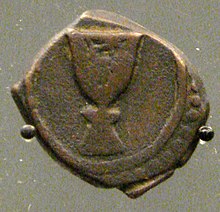as-Salih Hajji II.
Al-Malik as-Salih / al-Mansur / al-Muzaffar Salah ad-Din Hajji (II.) Ibn Shaban ( Arabic الملك الصالح / المنصور / المظفر صلاح الدين حاجي بن شعبان, DMG al-Malik aṣ-Ṣāliḥ / al-Manṣūr / al-Muẓaffar Ṣalāḥ ad-Dīn Ḥāǧǧī b. Šaʿbān ; † 1390 in Cairo ) was Sultan of the Mamluks in Egypt from 1381 to 1382 and from 1389 to 1390 .
First reign
After the death of Sultan al-Mansur Ali II in May 1381, the powerful Circassian Mamluk emir Barquq put another descendant from the Qalawun dynasty on the throne with the underage al-Salih Hajji . The new sultan was reportedly a precocious, depraved child and a sadist who loved to torment the women of his harem . In November 1382, Barquq decided - as it turned out a little prematurely - that he was now powerful enough to make himself sultan. Unrest in Syria eventually called for a strong man to drive the empire. Hajji II was deposed and Barquq was able to get his recognition as the first sultan of the Circassian Burji dynasty after fierce fighting, in the course of which he eliminated competitors .
Second reign
It turned out that Barquq's takeover of power in 1382 was a little premature and resulted in another period of political turmoil and civil war. In 1389, under the leadership of the governors of Malatiya in eastern Anatolia and Aleppo , ie the emirs Mintash and Yalbugha, a revolt of Syrian governors broke out. With the support of Arab theologians, some of these Mamluks wanted to hand over all spiritual and secular power to the Abbasids again and set up the Cairo caliph al-Mutawakkil I (1362-1377, 1377-1383 and 1389-1406) as sultan. They enlisted the support of Turkmen and Mongols, occupied Damascus and marched on Cairo in the spring of 1389. When other emirs joined the rebellion in Cairo, the uprising spread to the capital, where Barquq had distributed weapons to the population, barricaded the streets and hastily reinforced the fortifications. The rebels fought for the citadel with slingshots and Greek fire . After more and more of his followers had defected to the enemy in spite of large donations of money, Barquq fled first to a tailor's shop and then took a favorable opportunity to go to the Kerak fortress . Hajji II was reinstated as sultan in May 1389, but the two leaders of the uprising, Mintasch and Yalbugha, soon fell out and fought each other - one holed up in the citadel, the other in the nearby Sultan Hasan mosque . A year later, with the help of local officials, Barquq managed to break free, to draw more and more emirs of the region with their Mamluks to his side and to recapture rule in Egypt in bloody battles. On February 1, 1390, he entered Cairo in triumph. Caliph Zakariya al-Mu'tasim (1386-1389) and Sultan Hajji II were captured, the latter locked in the citadel and left to his dubious amusements there.
literature
- Jörg-Dieter Brandes: The Mameluks. The rise and fall of a slave despotism. Thorbecke, Sigmaringen 1996, ISBN 3-7995-0090-1 , p. 198 f.
- Robert Irwin : The Middle East in the Middle Ages. The Early Mamluk Sultanates 1250-1382. ACLS History E Book Project, New York NY 2008, ISBN 978-1-59740-466-2 , p. 149.
- Jörg-Ronald Kessler: The world of the Mamluks. Egypt in the late Middle Ages 1250–1517 (= Islamic studies . Special volume). Schwarz, Berlin 2004, ISBN 3-87997-319-9 , p. 6.
Remarks
- ↑ The throne name changed.
- ↑ The latter is not to be confused with the almighty commander in chief of the army under al-Nasir al-Hasan , al-Mansur Muhammad II and al-Ashraf Shaban .
- ↑ The advocates of a rule by the caliph did not prevail at that time.
| predecessor | Office | successor |
|---|---|---|
| al-Mansur Ali II. |
Sultan of Egypt ( Bahri dynasty ) 1381–1382 and 1389–1390 |
Barquq |
| personal data | |
|---|---|
| SURNAME | as-Salih Hajji II. |
| ALTERNATIVE NAMES | al-Malik as-Salih Salah ad-Din Hajji ibn Shaban |
| BRIEF DESCRIPTION | Sultan of the Mamluks in Egypt (1381-1382 and 1389-1390) |
| DATE OF BIRTH | 14th Century |
| DATE OF DEATH | 1390 |
| Place of death | Cairo |
